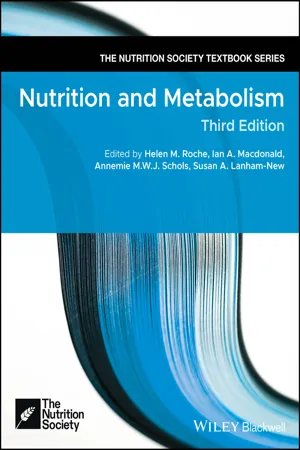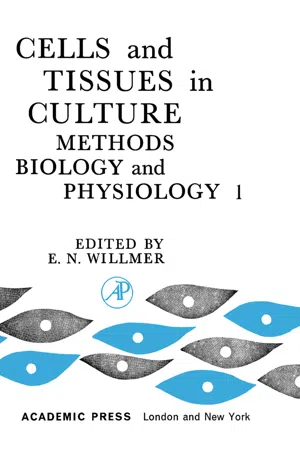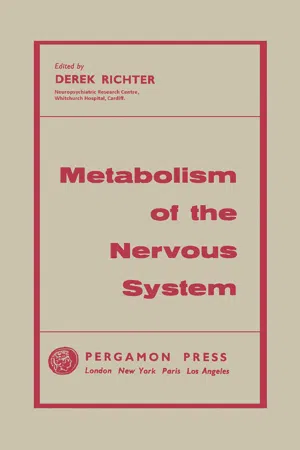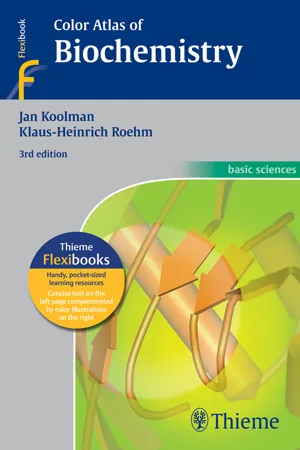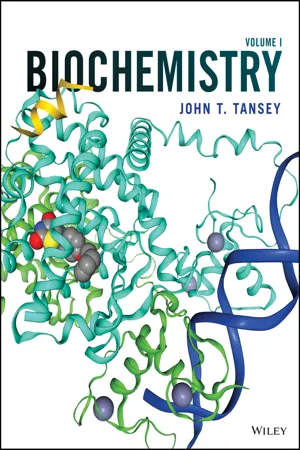Biological Sciences
Amino Acid Metabolism
Amino acid metabolism refers to the processes by which the body synthesizes and breaks down amino acids. This includes the conversion of amino acids into energy, the production of new proteins, and the elimination of excess nitrogen. Key pathways involved in amino acid metabolism include transamination, deamination, and the urea cycle. These processes are essential for maintaining proper cellular function and overall health.
Written by Perlego with AI-assistance
Related key terms
1 of 5
10 Key excerpts on "Amino Acid Metabolism"
- eBook - PDF
- Helen M. Roche, Ian A. Macdonald, Annemie M. W. J. Schols, Susan A. Lanham-New(Authors)
- 2024(Publication Date)
- Wiley-Blackwell(Publisher)
Nutrition and Metabolism, Third Edition. Edited on behalf of The Nutrition Society by Helen M. Roche, Ian A. Macdonald, Annemie M.W.J. Schols and Susan A. Lanham-New. © 2024 John Wiley & Sons Ltd. Published 2024 by John Wiley & Sons Ltd. Companion Website: www.wiley.com/go/nutrition/metabolism3e 5 Integration of Metabolism 3: Protein and Amino Acids Emily J. Ferguson, Nicholas A. Burd, Tyler A. Churchward-Venne, and Chris McGlory 5.1 Introduction Dietary protein is a key macronutrient required for optimal health and bodily function. Protein ingestion is crucial for the synthesis of new tis- sue and maintenance of whole-body energy homeostasis with roles in membrane transport, enzymatic function, cellular signalling and structure. Proteins are polypeptide chains composed of amino acids. Amino acids are precursors for protein synthesis and, interestingly, some amino acids serve as substrates for the production of neurotransmitters, catecholamines and nucleo- tides. Net protein mass (i.e. the amount of protein we have) is determined by the algebraic difference between rates of protein synthesis and rates of protein breakdown that can be evaluated at whole-body or tissue-specific levels. In the rested, fasted state, we exist in a state of negative whole-body net protein balance where rates of protein breakdown are greater than rates of pro- tein synthesis. Enhanced rates of protein break- down result in the liberation of amino acids that are either recycled for the formation of new pro- teins or metabolised to support energy produc- tion. In contrast, the ingestion of dietary protein, especially sources rich in indispensable/essential amino acids, has been shown to be most effec- tive to elevate rates of protein synthesis, Key messages • Protein and Amino Acid Metabolism are tightly regulated processes that involve the integration of numerous organ systems and support a variety of biological pathways. - eBook - PDF
Cells and Tissues in Culture
Methods, Biology and Physiology
- E. N. Willmer(Author)
- 2015(Publication Date)
- Academic Press(Publisher)
CHAPTER 9 Amino Acid and Protein Metabolism II. FURTHER ASPECTS OF THE AMINO ACID AND PROTEIN METABOLISM OF TISSUES IN CULTURE J. A. L U C Y * Strangeways Research Laboratory, Cambridge, England I. Introduction 297 II. Nutritional Studies 298 A. Experimental procedures 298 B. Non-essential amino acids 299 G. Essential amino acids 300 D. Discussion 301 III. Utilization of Amino Acids 302 A. Introduction 302 B. Comparative utilization 303 IV. Protein Metabolism 305 A. Synthesis 305 B. Induction and repression 307 C. Turnover and catabolism 309 V. Conclusion 311 References 312 I. INTRODUCTION It has been shown in Chapter 2 that Tissue Culture embraces a number of different methods, each of which has advantages and disadvantages for particular purposes. When it is proposed to use Tissue Culture in the study of a specific problem, it is essential to choose the particular method that is best suited to the investigation in hand. For example, serially propagated cell lines may be the preferred technique if one is interested in the amino-acid metabolism of rapidly growing tissues; the metabolic characteristics of cell strains have been discussed in the previous chapter by Eagle and Levintow. On the other hand, if the investigator is concerned with, for example, the study of the amino-acid and protein metabolism of differentiation, or the metabolic interactions of different types of cells within one tissue, then other methods are clearly more suitable. Furthermore, when a primary •Member of the external staff of the Medical Research Council. 298 J. A . LUCY interest is the metabolism of normal cells in vivo, a technique of culture that does not employ cell strains may be preferable in view of the pos-sibility that changes in metabolism occur before cells are able to multiply rapidly in culture. Increased attention may be paid in the future to short-term organ and explant cultures as a result of the accumulating observations on the metabolic abnormalities of long-term strains. - eBook - PDF
- Derek Richter(Author)
- 2013(Publication Date)
- Pergamon(Publisher)
SECTION 11 Protein and Amino Acid Metabolism METABOLISM OF PROTEINS AND AMINO ACIDS HEINRICH WAELSCH Department of Biochemistry, College of Physicians and Surgeons, Columbia University, and the New York State Psychiatric Institute, New York, New York I. Introduction II. Scope of the Review III. General Aspects of the Study of the Free Amino Acids of the Nervous System IV. Peptides in Brain Tissue V. Amino Acid Concentration in Different Parts of the Brain VI. Enzymatic Mechanism for the Conversion of Amino Acids into Each Other VII. Transamination VIII. Decarboxylases IX. Oxidation of Amino Acids X. Rejuvenation of the Amino Acid Pool XL Protein Metabolism XII. The Turnover Studies of Brain Proteins XIII. Turnover Rates of Proteins in Different Areas of the Brain XIV. Turnover of Proteins of Cell Organelles of Brain Cortex XV. Phosphoproteins XVI. Proteinases and Peptidases XVII. Microsomes and Nissl Granula XVIII. Conclusion I . I N T R O D U C T I O N T H E s τ υ D Y of the biochemistry of the three major components of the nervous system has in its history passed through three phases. At first, and for many years exclusively, the attention of histologists and biochemists was focused on the distribution, composition, formation and breakdown of lipids which can be easily visualized by histological techniques and which play a con-spicuous part in the process of myelination unique for the nervous system. With the development of our understanding of the role of carbohydrates in the energy metabolism of living matter, this period was followed by an ever-in-creasing interest in carbohydrate metabolism, an interest which recently received a considerable boost from studies of cell organelles and of the brain in vivo and in situ. Whereas most studies of lipid metabolism are still chemical and analytical in nature, those concerned with carbohydrate metabolism are mainly 431 432 H E I N R I C H W A E L S C H investigations of intermediary metabolism. - eBook - PDF
- William S. Hoar, David J. Randall, Anthony Farrell, Anthony P. Farrell(Authors)
- 2001(Publication Date)
- Academic Press(Publisher)
3 Amino Acid Metabolism J. S. BALLANTYNE I. Introduction II. Digestion and Uptake of Amino Acids III. Delivery Systems IV. Tissues A. Liver B. Gill C. Kidney D. Blood E. Muscle F. Brain G. Intestine V. Exercise VI. Hormonal Regulation A. Cortisol B. Insulin and Glucagon C. Thyroid Hormones VII. Diurnal Rhythms in Amino Acid Metabolism VIII. Diet and Starvation IX. Temperature X. Salinity XI. Anoxia XII. Summary References I. INTRODUCTION Amino acids have numerous functions in fish. The most familiar role amino acids play is as the building blocks of proteins. Protein synthesis can account for a substantial portion (20 – 42%) of the energy expenditures of growing fish (Hou-lihan et al., 1993, 1995). Most (85%) fish species are carnivorous (Love, 1980) and optimal growth requires very high dietary protein levels (30 –55% crude pro-77 Fish Physiology, Volume 20: Copyright 2001 by Academic Press. NITROGEN EXCRETION All rights of reproduction in any form reserved. tein) (Wilson, 1989). Fish display an efficiency of conversion of dietary protein to tissue protein that is up to 20-fold higher than that observed for chickens, pigs, and cattle (Tacon and Cowey, 1985). The efficiency of conversion of dietary pro-tein into tissue protein is somewhat paradoxical given that fish rely extensively on amino acids as energy sources and thus burn the precursors for proteins. Several hypotheses have been put forward to explain this. Certainly, the direct excretion of ammonia as the end product of nitrogen metabolism is more energetically fa-vorable than expending energy to convert it to less toxic forms such as urea or uric acid. The direct oxidation of dietary amino acids also avoids the energetic expense of synthesizing storage molecules such as glucose and lipids for subse-quent use. In energetic terms, a major function of amino acids is as catabolic substrates to provide ATP for biomechanical, synthetic, and transport processes. - eBook - ePub
Amino Acids
Biochemistry and Nutrition
- Guoyao Wu(Author)
- 2021(Publication Date)
- CRC Press(Publisher)
10 Regulation of Amino Acid MetabolismA metabolic pool of free amino acids (AAs) in organs (e.g., skeletal muscle, liver, and kidneys), tissues (e.g., the blood, white adipose tissue, and skin), cells (e.g., hepatocytes, macrophages, and lymphocytes), and intracellular organelles (e.g., cytoplasm and mitochondria) is relatively constant in healthy individuals at a given developmental stage (Figure 10.1 ). This reflects the fine balance between the supply of AAs (exogenous and endogenous) and their utilization. In the postabsorptive state, the concentrations of AAs [including nutritionally essential AAs (EAAs) and so-called nutritionally non-essential AAs (NEAAs)] in the plasma and tissues do not fluctuate substantially so as to maintain desirable concentration gradients between the plasma and tissues or cells (Hou et al. 2020 ; Jungas et al. 1992 ; Li et al. 2020 ; Wester et al. 2015 ). As illustrated in studies with rapidly growing pigs, concentrations of most AAs in cells and tissues (except for arginine in the mammalian liver) are much greater than those in the plasma (Table 10.1 ). It is noteworthy that concentrations of free AAs in the plasma and tissues vary with species, developmental stage, nutritional state, endocrine status, physical activity, time of the day, and diseased condition (Brosnan 2003 ; Gilbreath et al. 2021 ; Gill et al. 1989 ; Li et al. 2021 ; Wheatley et al. 2014 ).FIGURE 10.1 - eBook - PDF
- Jan Koolman, Klaus-Heinrich Röhm(Authors)
- 2012(Publication Date)
- Thieme(Publisher)
Amino Acid Metabolism in the liver B. Urea cycle Alanine trans-aminase [PLP] Aspartate trans-aminase [PLP] Glutaminase Glutamate dehydrogenase Transamination Oxidative deamination Hydrolytic deamination 1 2 3 4 Fumarate Arginine Ornithine Citrulline Arginino succinate Glucose Aspartate Urea Gluconeogenesis Ornithine/Citrulline Antiporter (ORNT 1) Ornithine Citrulline Carbamyl phosphate N -Acetyl glutamate Cytoplasm Matrix From the blood Urea cycle, bio-syntheses From the blood Urea cycle OAA: oxaloacetate, 2-oG: 2-oxoglutarate Protein Metabolism 174 Amino Acid Biosynthesis A. Synthesis of nonessential amino acids All amino acids that can be produced by trans-amination from the 2-oxoacids of intermedi-ary metabolism, as well as their amides, can be synthesized by humans themselves. These are the members of the glutamate family (Glu, Gln, Pro, Arg, derived from 2-oxoglutarate), the aspartate family (including only Asp and Asn, derived from oxaloacetate) and alanine (Ala, derived from pyruvate). The amino acids of the serine family (Ser, Gly, Cys) can also be synthe-sized by humans. Comparison of the diagram with page 169, B shows that many non-essential amino acids are synthesized by reversing reactions that are involved in their degradation. Deamination of serine to pyruvate (p. 166) cannot be reversed. Serine is therefore produced in two steps from 3-phosphoglycerate, an intermediate of gly-colysis. B. Amino acid requirements Plants and microorganisms are able to synthe-size all of the amino acids in full, but during the course of evolution, mammals have lost the ability to synthesize approximately half of the 20 proteinogenic amino acids. These essen-tial amino acids therefore have to be supplied in food as components of proteins. For exam-ple, animal metabolism is no longer capable of synthesizing the aromatic amino acids (tyro-sine is only nonessential because it can be formed from phenylalanine when there is an adequate supply available; p. 170). - eBook - PDF
The Liver
Morphology, Biochemistry, Physiology
- Ch. Rouiller(Author)
- 2013(Publication Date)
- Academic Press(Publisher)
In The Enzymes (P. D. Boyer, H. Lardy, and K. Myrbäck, eds.), Vol. 5, pp. 563-570. Academic Press, New York. Greenberg, D. M., ed. (1961b). Metabolic Pathways, Vol. 2. Academic Press, New York. Greenstein, J. P., Winitz, M., Gullino, P., Birnbaum, S. M., and Otey, M. C. (1956a). Studies on the metabolism of amino acids and related compounds in vivo. I. Toxicity of essential amino acids, individually and in mixtures, and the protective effect of L-arginine. Arch. Biochem. Biophys. 64, 319-331. Greenstein, J. P., Winitz, M., Gullino, P., Birnbaum, S. M., and Otey, M. C. (1956b). Studies on the metabolism of amino acids and related compounds in vitro. III. Prevention of ammonia toxicity by arginine and related compounds. Arch. Biochem. Biophys. 64, 342-354. Grisolia, S., and Cohen, P. P. (1948). Study of carbon dioxide fixation in the synthesis of citrulline. /. Biol. Chem. 176, 929-933. Gros, F. (1961). Aspects récents du problème de la biosynthèse des protéines. Biochemie Médicale 23, 231-254. Grossi, L. G., and Moldave, K. (1960). The effect of soluble factors on the transfer of amino acids from soluble ribonucleic acid to microsomal proteins. /. Biol. Chem. 235, 2370-2374. Gutman, H. R., and Wood, J. L. (1951). A note on the acetylation of sulfur amino acids by liver and kidney. /. Biol. Chem. 189, 473-477. Hall, D. A. ( 1952 ). Histidine α-deaminase and the production of urocanic acid in the mammal. Biochem. J. 51, 499-504. Handler, P., Kamin, H., and Harris, J. S. (1949). The metabolism of paren-terally administered amino acids. I. Glycine. /. Biol. Chem. 179, 283-301. Hardegg, W., and Heilbronn, E. (1961). Oxidation von Serotonin und Tyramin durch Rattenlebermitochondrien. Biochim. et Biophys. Acta 51, 553-560. 534 H. TARVER Harding, H. R., Rosen, F., and Nichol, C. A. (1961). Inhibition of hepatic alanine transaminase activity in response to treatment with 11-deoxycorticosterone. Proc. Soc. Exptl. Biol. Med. 108, 96-99. Harper, Η. Α., Najarian, J. - eBook - PDF
Sports Nutrition
Energy Metabolism and Exercise
- Judy A. Driskell, Ira Wolinsky, Judy A. Driskell, Ira Wolinsky(Authors)
- 2007(Publication Date)
- CRC Press(Publisher)
90 1. Oxidation of Amino Acids .............................................................. 91 G. Gluconeogenesis ..................................................................................... 92 1. Amino Acids and Gluconeogenesis ................................................ 93 2. Hormonal Control of Gluconeogenesis........................................... 95 3. Effects of Amino Acids on Hepatic Glucose Metabolism ............. 96 H. Use of Amino Acids for Energy — Catabolic Effects of Exercise....... 96 1. Amino Acid Metabolism in Muscle ................................................ 97 2. Pathways of Amino Acid Metabolism in Muscle ........................... 97 3. Skeletal Muscle Catabolism ............................................................ 97 4. Oxidation of Amino Acids .............................................................. 98 I. Glucogenic and Ketogenic Amino Acids ............................................. 101 1. Glucogenic Amino Acids .............................................................. 102 2. Ketogenic Amino Acids................................................................. 102 3. Alanine and Glutamine.................................................................. 102 4. Interorgan Exchange of Amino Acids ........................................... 104 J. Protein Metabolism and Ammonia ...................................................... 105 1. Metabolism of Ammonia............................................................... 105 2. Urea Formation by the Liver......................................................... 107 3. High Levels of Protein Intake and Ammonia ............................... 108 K. Low-Carbohydrate, High-Protein Diets and Energy Metabolism ....... 109 1. Metabolic Advantage of a High Protein, Low-carbohydrate Diet .................................................................. 109 2. Low-Carbohydrate Controversy .................................................... - eBook - PDF
Protein Deposition in Animals
Proceedings of Previous Easter Schools in Agricultural Science
- P.J. Buttery, D.B. Lindsay(Authors)
- 2013(Publication Date)
- Butterworth-Heinemann(Publisher)
Introduction The amounts and kinds of amino acids participating in the metabolism of different tissues of the intact animal are only incompletely understood. In 69 INTEGRATION OF WHOLE-BODY Amino Acid Metabolism 70 Integration of whole-body Amino Acid Metabolism Experimental techniques Most of the studies to be reviewed were performed using multicatheterized and continuously fed adult sheep. Polyvinyl catheters were surgically implanted into the portal, hepatic and renal veins, lower vena cava and aorta to measure veno-arterial amino acid concentration differences across the portal-drained viscera (digestive tract plus pancreas and spleen), liver, kidneys and hindquarters (Katz and Bergman, 1969; Kaufman and Bergman, 1974; Heitmann and Bergman, ruminants, the significance of fermentation in the reticulorumen has led to considerable research on rates of amino acid degradation and disappearance within the digestive tract, but this gives little or no information on actual avail-ability or metabolism by different organs. Further, the animal must integrate and change its metabolism to adapt to different nutritional, physiological or stressful situations. Notable among the latter are starvation, and even acidosis which can occur under conditions of high grain feeding. Some tissues that undoubtedly have high requirements for amino acids even in the adult animal are the gut epithelium, liver, muscle, kidneys, and, of course, the mammary gland and developing fetuses. Intestinal epithelial cells are known to have an extremely rapid rate of turnover and large quantities of amino acids must surely be required for their formation. Further, virtually unknown quantities of dietary amino acids are metabolized by the gut epithelium during the process of absorption (Bergman and Heitmann, 1978; Neame and Wiseman, 1958). - eBook - PDF
Biochemistry
An Integrative Approach
- John T. Tansey(Author)
- 2019(Publication Date)
- Wiley(Publisher)
This section describes how different amino acid skeletons are broken down for energy or long-term storage as fat. Many amino acid derivatives are 11.4 Pathways of Amino Acid Carbon Skeleton Scavenging 415 important signaling molecules, cofactors, or metabolic intermediates. Those pathways are not discussed here, except in terms of where these metabolites lead. Amino acids can be categorized as glucogenic, producing breakdown products which undergo gluconeogenesis, or ketogenic, producing breakdown products which can only produce ketone bodies (Figure 11.12). There are only two solely ketogenic amino acids: leucine and lysine. Some amino acid skeletons, such as threonine, have their carbons catab- olized into both glucogenic and ketogenic substrates but are considered glucogenic amino acids because they contribute to glucose production. In addition, any amino acid can be bro- ken down and stored as fat; when consumed in excess, this is the fate of many amino acids. Although numerous reactions are involved in amino acid catabolism, most of them can be ordered into a few categories. The first reaction is generally the removal of the amino group, often through a transamination to an α-keto acid as discussed in section 11.2. The reactions of amino acid catabolism are often similar to those seen in β-oxidation, in that carbon skele- tons are desaturated (an FAD-dependent process), hydrated to an alcohol, and then oxidized to a carbonyl (an NAD + -dependent process). Hydroxylation of rings or ring opening often involves molecular oxygen and the dioxygenase class of enzymes. Finally, carbon groups can be added or lost as CO 2 , or removed by tetrahydrofolate-dependent reactions (Figure 11.13). Like fatty acids and carbohydrates, the carbon skeleton of an amino acid is catabolized via the citric acid cycle; however, in contrast to fatty acids and carbohydrates, there are multiple places where the carbon skeletons of amino acids can contribute.
Index pages curate the most relevant extracts from our library of academic textbooks. They’ve been created using an in-house natural language model (NLM), each adding context and meaning to key research topics.
